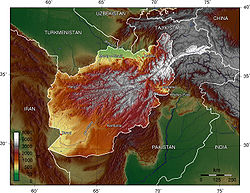Bamiyan
|
بامیان Bamiyan
|
|
|---|---|
| Basic data | |
| Country | Afghanistan |
| Capital | Bamiyan |
| surface | 14,175 km² |
| Residents | 447,200 (2015) |
| density | 32 inhabitants per km² |
| founding | 1964 |
| ISO 3166-2 | AF-BAM |
| politics | |
| governor | Mohammad Tahir Zahir |
Coordinates: 34 ° 48 ' N , 67 ° 12' E
Bamiyan , other transcriptions Bamian or Bamyan ( Pashto / Dari بامیان, DMG Bāmiyān ), is a province of Afghanistan with around 447,200 inhabitants.
It is located in the center of the country in the Hazarajat (also: Hazaristan) region. Its capital of the same name is the largest city in the Hazarajat and the cultural center of the Hazara ethnic group .
The province became internationally known for the Buddha statues of Bamiyan , which were destroyed in 2001 under the Taliban regime .
history
In antiquity , central Afghanistan was a strategically favorable place, as it was on the Silk Road and thus on the route of the traders between the ancient Mediterranean region (the Hellenistic world of states and later the Roman Empire ) and Persia in the west and China and India in the east ( see also India trade ). Bamiyan was a stopping point for many travelers. The Greek, Persian and Buddhist arts were brought together here, forming a unique style of Graeco-Buddhist art.
Bamiyan was the seat of several Buddhist monasteries. Many Buddha statues were carved into the rock. These rock statues were located near the town of Bamiyan in the valley of the river of the same name . The two largest statues measured 53 and 35 meters in height without their niches in which they stood. Today only their niches are left. The niche of the large sculpture, actually Dipamkara , by the people of Khonuk But ; Persian خنک بت(cold or white statue) or Solsol or Salsal ;صلصل(Light shines through the universe) is 58 m high. The niche of the smaller, actually Siddhartha Gautama , from the people of Sorkh But ;سرخ بت (red or glowing red statue) or شاه مامه; Shahmama (Queen Mother) called, is 38 m high. Before the statues were completely destroyed by the Taliban in March 2001 , the 53 m high statue had rock stairs, a kind of spiral staircase that you could use to get to its head, stand upright and look down on the area. In addition, despite the destruction, a large part of the huge system of rock stairs, niches, balconies, assembly rooms, altar rooms with domed ceilings and caves still exist . An estimated 3,000 and 5,000 Buddhist monks lived in the rock caves with water and sewer systems - water reservoirs from the melting snow on the 2500 m high plateaus of the Hindu Kush. Today a large number of Hazara also live in the rock niches and caves.
The creation of the statues was dated to the 6th century AD, when the place Bamiyan developed as a stopover on the trade route from India via the Hindu Kush to Sogdia . The Buddha statues were a special feature of the landscape of the Bamiyan Valley, which, with its archaeological remains, is included on UNESCO's World Heritage List . In March 2001, the Taliban regime ordered the destruction of the statues that were viewed as idols. The destruction was carried out with surface-to-air artillery and explosives .
The province was re-established in 1964. Previously the area belonged to the provinces of Kabul and Parwan .
present
Today (2009) Bamiyan is considered to be comparatively peaceful and safe. As in the other provinces of Hazarajat, the cultivation of opium poppies for opium production is hardly widespread. The governor, Habiba Sarabi , is the only woman in this office in the country. The province tries to open up its cultural and landscape riches for tourism again. The Band-e-Amir Lakes have been designated as the only national park in Afghanistan since 2009.
- Sports
On November 4, 2016, a marathon took place in Bamiyan, in which female athletes participated for the first time.
Administrative division
Bamiyan Province is divided into the following districts:
literature
- Joseph and Ria Hackin : Le site archéologiques de Bamyan. Guide you visiteur . Paris 1934.
- Ivica Brnić, Florian Graf, Wolfgang Rossbauer, Christina Lenart (eds.): Venturing Permanence. The ETH House of Science in Bamiyan. Gta Verlag, Zurich 2012. ISBN 978-3-85676-210-0 .
Web links
- Community portal for the preservation and reconstruction of the cultural heritage of the Bamiyan region
- Investigation of the condition and stability of the rock niches of the Buddha statues by Bamiyan, ICOMOS expert group and University of the Bundeswehr Munich, 2002
- Investigation, conservation and restoration of the ceiling and wall paintings in the Kuti-e Baghtscha pavilion in the presidential palace in Kabul (Afghanistan), financed by the ARG Afghan Rehabilitation Group, the Federal Foreign Office and the Gerda Henkel Foundation 2010
- (...) until having climbed a steep rock staircase cut deep inside a cliff we emerged onto the top of the head of the Buddha.
Individual evidence
- ^ Afghanistan. In: citypopulation.de. Retrieved January 8, 2016 .
- ↑ Spiegel-Online Kultur Taliban behead giant statue
- ^ Synopsis The Giant Buddhas
- ↑ http://othes.univie.ac.at/12702/1/2010-12-01_0309225.pdf The Buddhist cave complex of Bamiyan
- ↑ D. Balland: BĀMĪĀN - iv. Modern province , in: Encyclopædia Iranica , accessed October 25, 2009
- ↑ Phil Zabriskie: Hazaras: Afghanistan's Outsiders , National Geographic , February 2008
- ↑ David Nauer: Where Afghanistan is a Dream Destination , August 2009
- ↑ The video blogs of the ARD correspondents ( Memento from November 14, 2016 in the Internet Archive ) Dilli, Dilli - stories from Delhi by Markus Spieker, November 11, 2016, 9:13 a.m., 8 min., Accessed on November 14, 2016




